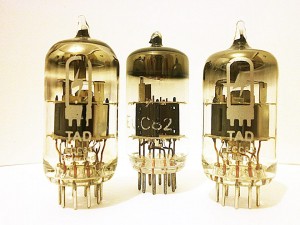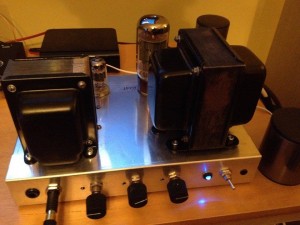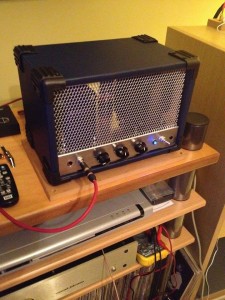It’s been a while since I’ve tried to dig in tube related circuits. In this “digital era” everything becomes digital for the shake of simplicity or “modern trend/fashion”. It is also handy and cheaper for a manufacturer to use solid state devices than tubes. That’s why we got solid state amps. But I wanted to build something the old way! Keep on reading..
It’s said that there are devices (transistor types like Fets,mosfets etc) that sound pretty much like tubes. This is a point for a really looong conversation. But undoubtedly there are situations where tube sounding devices, sound like tubes.
But (there is always a “but”) nothing sounds warm, clean and crisp like a tube. Not to mention that even the same type of tubes made by the same manufacturer may have different character. I’ve build my first tube amp a month or so ago. All I wanted was pure tube character that could get a little bit dirty. So I designed 2 gain stages that are not really dirty. It simply gets some warm overdrive, but nothing more than this. A classic tone, known and respectful.
It was build by materials found in the shelves. A good friend of mine helped me out on this. We started this amp project for fun, but it turned out great. It’s a class A single ended amp. Output power 6.5W maximum. That small head rocks! And it rocks hard!
My amp design philosophy was born due to some simple thoughts and it goes pretty simple as this : Get the most of the tube character out with as low cost, low watts, small size as you can. Can this be done? Yes it can. There are a lot of resources and books out there for everyone to read. So there is no secret here. It’s a choice. Most of the tube amp manufacturers, build their amps with some parameters in mind. These parameters are there to fulfill the needs of the guitarist in specific situations. Not in all situations. Not in everyday life. What do i mean? I will explain it in a second.
Most of the tube amps out in the market are classified based on their wattage. That’s their basic criterion. But what does it really mean? And how does it affect our sound? A e.g. 40W amp head, means that when it it cranked up, their output transformer is loaded with an X amount of voltage that is converted to sound trough the speaker. This power is measured in Watts and in our example, the power tubes load the transformer with 40W of power. How this is done, is a matter of amp design, topology, tube characteristics, power voltage etc.
Where do I (as a musician) need my 40W output? Well, not for practice. Not in my room. Even in a rehearsal I won’t be able to crank it up. It’s pretty loud..So, I keep the “volume down”. Hold that for a second.
Keeping the volume low, means that the power amp (a stage inside you amp) works really low level. With no effort. That’s good for the output tubes. But it’s not good for your sound (when playing in low volume situations). You can’t really enjoy tube sound with the volume low. The tube character is not profound. It’s like driving a Ferrari at 10mph. Sucks..
So, high wattage is needed for live performances, in open spaces, where you need a lot of power to show off. There, you can crank things up, and you may need even more power depending on the situations.
My design approach is the opposite. That is “get the tubes to work hard, keep the wattage low” so you can enjoy tube sounding character in your room. Guitar players spend a lot of time practicing, rehearsing or recording in the studio.
My design proves, that with specific architecture, I can get the tube’s operating state in the desired level (clean/smooth/overdriven/heavily clipping) and then, feed this to the power amp which is of low wattage output.
This way, i can have raw tube distortion or chiming clean sounds feeding a low watt amp that drives a 12” speaker.
It’s damn loud for your room, but with the output volume at half, you can enjoy real TUBE sound!!
You can record, practice, play with your band etc. This philosophy builds “small monsters”. So don’t let wattage fool you.
What matters is operation state, and class of operation. Big amp companies aim to different type o guitarists. That’s the market status : Why own a 20W amp when you can have a 60W or 100W or 400W? Channels? How many? Nothing bad in all these. But my approach is different.
As I said before, it’s a matter of CHOICE. If you seek deep inside you, you will find that most of your guitar time is spend on practice. Wouldn’t it be great to have a small “screaming” monster as your partner? Rehearse with your band? The same monster won’t let you down. Record in the studio? No problem. I’ve paired this small amp with my Soul Breaker distortion pedal. I won’t replace this setup in 100 years. Sounds amazing.
I believe that in few years, big companies will start building amps with this philosophy. Reason? They ‘ve build everything but this. They may add digital stuff in them, but there is nothing better than a small “swiss knife” amp head. Mark my words..
I will soon post some videos for you to check it’s sound. For the moment, my heads are being modified in my new parameters.
This is the low gain model video and below that you can find the audio of the high gain amp. (both models are still being fine tuned)
Check out this 6l6-tube-guitar-amp page for the detailed information of this head, its construction etc by my fellow partner Costas Sarris
[soundcloud url=”https://api.soundcloud.com/tracks/130006277″ params=”color=ff6600&auto_play=false&show_artwork=true” width=”100%” height=”166″ iframe=”true” /]


